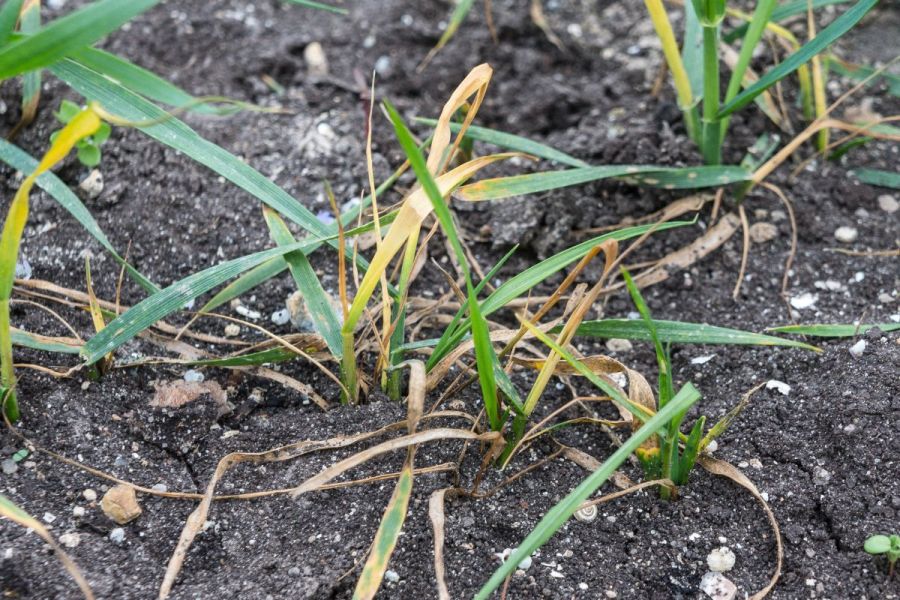Wheat bulb fly is a pest that’s been in slow decline over the past 10 years but, given the right conditions, it can still pack a punch in cereal crops. CPM looks at some new research that will better predict seasonal risk and how to manage it without insecticides.
“We’re heading towards a future where we are far less reliant on insecticides.”
By Adam Clarke
Arguably, insect pests now provide one of the greatest challenges for crop producers and their agronomists. While other threats, like weeds and fungal pathogens, are becoming harder to control due to loss of crop protection products and resistance, concerns over the impact of insecticides on non-target fauna has hit insecticide availability hard.
As a consequence, it’s become very difficult to bring new products to the market. And that’s before considering the impact of a changing climate, which is making local seasonal risk much harder to predict.
One insect that has become more complicated to manage over recent years is wheat bulb fly. Previous control relied on organophosphate insecticides, chlorpyrifos and dimethoate, which were withdrawn in the mid 2010s.
Chlorpyrifos targeted the larvae after they hatched and before they managed to burrow into cereal seedlings, preventing the dead heart symptoms synonymous with wheat bulb fly attack.
Dimethoate was utilised as a dead heart spray, giving some control of larvae already feeding inside plants, and provided a last line of defence against significant crop damage.
The product losses led to DOW AgroScience (now Corteva) withdrawing commercial funding for PestWatch, an ADAS-led initiative which monitored wheat bulb fly egg hatch progress across the country and advised growers when to apply Dursban WG (chlorpyriphos).
AHDB continued to fund an autumn survey – an ADAS-led initiative running since 1984 – which identifies annual wheat bulb fly risk using egg extraction from soil samples taken at 30 reference sites. However, the process is both costly and time consuming, says AHDBcrop protection scientist Siobhan Hillman.
“Large quantities of soil are processed to get the results and isn’t necessarily representative of a farm’s local risk, given the relatively low number of reference sites,” she says.
To try and improve the information the autumn survey provides, a recent AHDB-funded research project has explored the potential of mathematical models to help growers manage the pest in the absence of the most effective chemical controls.

Steve Ellis explains that entomologists have been working with crop physiologists to try and develop a non-chemical WBF control strategy to limit impact on yield.
According to the project’s lead, ADAS entomologist Steve Ellis says it’s hoped that this will lead to more timely and accurate forecasting of WBF risk, allowing cereal growers to adapt cereal crop management to minimise damage.
He explains that thinking on wheat bulb fly can be divided into two strands – one which looks at conventionally timed sowings (September to October) when growers have no chemical options to control WBF.
The second is late sowings (November onwards) when growers have the option of using Signal 300 ES (cypermethrin) to protect seedlings from invading larvae at their most vulnerable stage.
“Because most crops will be sown in the conventional window where there’s no chemical intervention, we’ve been working with crop physiologists to try and develop a non-chemical control strategy to limit impact on yield,” says Steve.
So why are physiologists involved? Having successfully helped update the threshold advice for pollen beetle in oilseed rape, by taking into consideration the amount of flower buds a plant could afford to lose before losing yield, similar logic was applied to the wheat crop.
A wheat crop requires about 500 shoots/m2 by GS31 to achieve its full potential. This can be increased to 600 shoots/m2 where a yield of 11t/ha plus is expected. Steve says this leads to the argument that, like oilseed rape and its flowers, there’s a reservoir of excess shoots most wheat crops can afford to sacrifice to wheat bulb fly before losing yield. Most conventionally timed drillings often have 1000 shoots/m2 at GS31, he points out.
“When we started to investigate this, we realised that we needed to be able to model or predict the number of shoots a crop will have at GS31, based on seed rate and sowing date. What the physiologists have done is produce that model, and it provides extremely valuable information to use in terms of managing wheat bulb fly.”
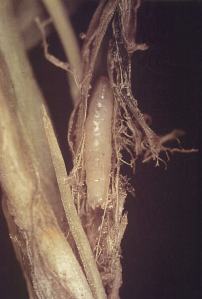
WBF eggs hatch from January to March and burrow into crops, feeding on shoots through March and April.
Knowing how many shoots a crop will produce and how many WBF eggs/m2 there are in the soil allows an estimate of how many shoots a crop is likely to lose, he explains.
Steve highlights that this calculation must also consider established knowledge about WBF biology, including the fact that not all eggs hatch – literature suggests just 46% produce a potentially damaging larva.
Furthermore, it’s known that each larva has four instars and get bigger and hungrier each time it moults. As the larva feeds and moves through those growth stages, it has the potential to eat up to four shoots.
“So, if we multiply the number of viable eggs by four, that will give the number of shoots that could potentially be lost in each crop. You can then subtract that from the potential number of shoots you expect to achieve from your sowing date and seed rate.
“Then you can start to think about how you can manipulate the seed rate and/or sowing date to produce more shoots if the damage takes you below the optimum 500-600 shoots/m2 threshold,” explains Steve.
The model needs further validation in the field, but it has the potential to be incorporated into a digital tool, he adds. This will allow a grower to enter basic data, such as wheat bulb fly infestation at a given location, sowing date, and planned seed rate. It could then offer a valuable management recommendation.
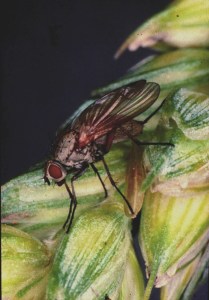
Wheat bulb fly adults lay their eggs on bare ground from July to September, which means potatoes or sugar beet may increase the risk in the following wheat crop.
“We’re heading towards a future where we are far less reliant on insecticides because the ones that are available are likely to become more expensive and fewer in number. We need to start thinking of other ways to manage these pests,” notes Steve.
On top of the modelling work, the project has also looked at how technology and modelling can make the soil egg count work more efficient. Currently, the process involves the ADAS team roaming around the 30 reference sites with a golf hole borer, taking 20 soil cores over a 4ha area. With each core weighing about the same as a bag of sugar, it means there are huge volumes of soil to take back to the lab for analysis, he explains.
Soil is then washed through sieves and all the bits of organic matter collected. This is then immersed in magnesium sulphate so the eggs float to the top and are picked off by a lab technician.
“It’s a lot of hard work taking the samples and takes a long time to wash it all through the apparatus, particularly if you have a clay soil that’s difficult to break down with the water,” explains Steve.
This led the project team to look at ways of assessing the numbers of wheat bulb fly eggs more cost effectively, a concept originally explored in the 1980s when researchers attempted to produce a model which made predictions based on weather data.
The original work accounted for about 50% of the variability in egg numbers from season to season, which Steve says was a reasonable start but not accurate enough to provide the basis for a management decision. Building on this, current ADAS researchers brought in a wider range of weather variables to see if it would increase the prediction accuracy.
“One of the issues with the current system is that we don’t get the autumn survey results until late September or early October, which is a bit too late for people to make seed treatment decisions.
“We’ve managed to get the weather-based model up to about 70% accuracy. The advantage over the survey is that weather data is live, and it gives an indication of wheat bulb fly risk much earlier in the season,” says Steve.
There are much higher numbers of wheat bulb fly eggs in organic soils in areas like Cambridgeshire than there are mineral soils, he adds. “Currently, there’s no concrete explanation as to why that might be. However, it’s information like this, contained in historic data from the autumn survey, that can be fed into the risk model to further improve its accuracy.”
Previous crop could also be another layer of information to incorporate. Some crops increase risk, such as potatoes and sugar beet, because they can leave soil exposed during the WBF egg-laying period.
“That’s something we’re looking into now. It’ll mean instead of lugging huge volumes of soil around each year, we’ll be able to plug meteorological and other data into the mathematical model to give growers an accurate and early indication of risk. It just needs some refinement,” says Steve.
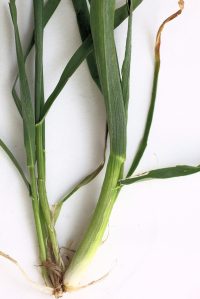
Gout fly is on the increase in many areas and it’s possible the new WBF model can be adapted to this and other Dipterous pests.
Wheat bulb fly is just one of several Diptera stem-boring pests that could benefit from similar models, with gout fly, frit fly and yellow cereal fly some examples relevant to UK cereal crops. Gout fly, in particular, has been on the rise in areas where blackgrass populations have historically been high, and growers pushed growers into more spring cropping, he says.
Most cereal crops (except oats and maize) can be affected, and the greatest risk is to those emerging before the end of September, which catch the autumn generation of flies, and late-sown winter and spring cereals which catch the spring generation. Gout fly larvae only takes out single shoots, but in late-sown winter and spring cereal crops that have little time to tiller, it can result in economically damaging infestations.
“While you are solving one problem with spring crops, you are potentially opening the door to another. Using the philosophy of entomologists and physiologists working together to combat the pest – looking at the crop first, rather than the pest – is something that we’re much more interested in now and it can be applied to gout fly.
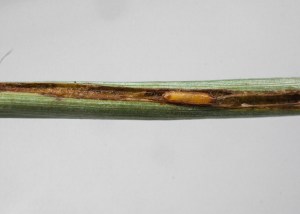
Gout fly larva pupated in upper stem of wheat plant after ear emergence in summer.
“It should produce much more practical, sustainable thresholds and control strategies which take into consideration the needs of the crop to hit optimum yield,” says Steve.
Siobhan says that before deciding if the autumn survey will continue, AHDB needs to understand its priority for levy payers. If wheat bulb fly does remain important, then it should attract some funding to keep the project going.
Similarly, developing a digital tool, like an app or web platform, for the wheat bulb fly models would need to be identified as a priority in grower feedback before making the leap. “We’d need to ensure that the tool is useful growers and would have longevity, as AHDB doesn’t want to start something that will only be stopped soon afterwards,” she concludes.
Autumn 2022 survey results
AHDB’s wheat bulb fly survey suggests it may be one of the lowest-risk seasons on record for this cereal pest. Despite the relatively low risk, almost one-third of sites had egg populations at levels that could have justified the use of seed treatments in late-sown winter wheat crops.
As part of the ADAS-led project, researchers analysed soil samples from 30 fields at elevated risk of economic damage. Siobhan, who manages pest research at AHDB, says the egg counts from the survey of soil samples provide a useful indication of risk.
“When combined with site-specific information, the results can help farmers determine the need for chemical seed treatments to protect their crops from attack,” she adds.
- Eastern England survey results (15 sites)
- Twelve were in the low-risk category (<100 eggs/m2).
- Two were in the moderate-risk category (101–249 eggs/m2).
- One was in the high-risk category (250–500 eggs/m2).
- No sites were in the very-high-risk category (<500 eggs/m2).
The highest egg count in this region was 274 eggs/m2, following potatoes at a site in Cambridgeshire. The average egg count was 62 eggs/m2.
- North of England survey results (15 sites)
- Nine were in the low-risk category (<100 eggs/m2).
- Six were in the moderate-risk category (101–249 eggs/ m2).
- No sites were in the high-risk or very-high-risk categories.
The highest egg count in this region was 173 eggs/ m2, following vining peas at a site in North Yorkshire. The average egg count was 100 eggs/m2.
Wheat bulb fly facts
- WBF (Delia coarctata) is a significant pest of all cereals, apart from oats, in eastern areas of the UK
- Adult flies lay eggs on bare soil in July to September
- Eggs hatch in January to March and burrow into crops and feed on shoots
- Feeding continues through March/April, when dead heart symptoms appear
- Larvae emerge from plants during April/May and pupate
Research Roundup
From Theory to Field is part of AHDB’s delivery of knowledge exchange on grower-funded research projects. CPM would like to thank AHDB for its support and in providing privileged access to staff and others involved in helping put these articles together.
For further info:
AHDB Project 21510022 (2112003): Autumn survey of wheat bulb fly incidence invested £32,000 in monitoring the pest and exploring alternative methods of predicting risk. Reports can be downloaded here.
This article was taken from the latest issue of CPM. For more articles like this, subscribe here.

